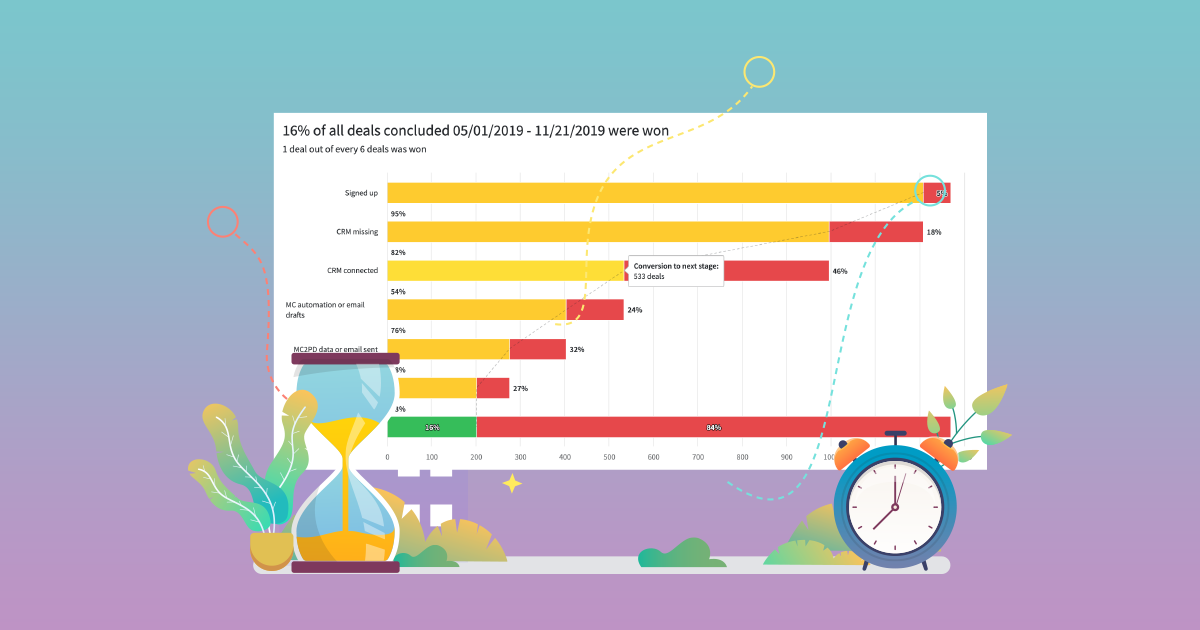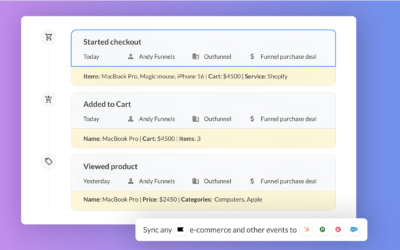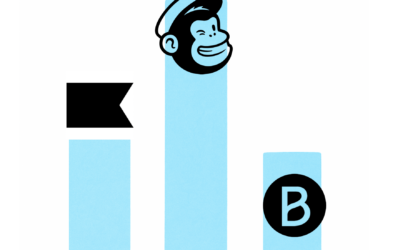Last updated: July 27, 2021
This is a case study of using affordable marketing tools (Pipedrive, Outfunnel and a bit of Mailchimp) for user onboarding email automation for our SaaS tool. We automated onboarding processes, without any product tours or interactive guides — and this saved more than 80% of our precious time while maintaining or even increasing activation rates.
While this post is about onboarding new users to software products, the same approach can be used to automate any digital customer-facing process whether it’s client onboarding, lead nurturing, customer lifecycle management or measuring customer satisfaction after delivering a product or service.
Background: who we are and why onboarding was important
As for background: Outfunnel is the most boring marketing tool on the planet. We connect sales and marketing data, deeply and easily. It’s not very exciting, but it is extremely useful if you’d like your sales and marketing teams to work together in driving revenue.
We have a free trial, so anyone can sign up, configure their funnel-specific marketing and sales integrations within minutes, and get value out of the product without sitting through a demo or ever speaking to us. We have a “self-service” model rather than “white glove”, to use industry lingo.
In reality, many new users have questions as they familiarise themselves with the automation platform, and many simply get stuck somewhere during initial onboarding, so we set out to create a hybrid onboarding process from day one.
Here’s a step by step guide as to how we went about it.
Stage 1: User onboarding by hand. Focus on the learning process
While our first features were publicly launched only in May of 2018, I had done more than 120 calls and meetings with reasonably qualified prospects even before starting to design our onboarding process.
This meant I had a pretty good idea about the customer profile, their needs, and their concerns. But I wasn’t 100% confident in our product’s ability to address these needs and I knew I didn’t know enough about making buying decisions specifically in the niche we were serving. I knew we needed more insights.
We use Chargebee to manage our subscriptions, and I used Zapier to send each new individual user to our Pipedrive account to manage onboarding users (see why we use Pipedrive vs an alternative like HubSpot). Our customer journey stages were more or less the following.
- Signed up – all signups got created in this “placeholder” stage.
- No activity – hadn’t connected any tools (that were required for using the product).
- Set up automation – had played with the product but without real usage.
- Live data moving – real data had been synced via the app, at least once (which counts as a meaningful action for us).
- Actively using – data actively being synced over multiple days, product adoption complete.
In the early days, we were lucky to get 5 signups per day, so I reviewed each of the signups and their product adoption by hand and moved them along the pipeline accordingly.
I then tried to get feedback and input from as many signups as possible. I had the habit of opening their website to get a better sense of who was on the other end, and I would aim to write each one. After all, we did not have a customer success team in the early days.
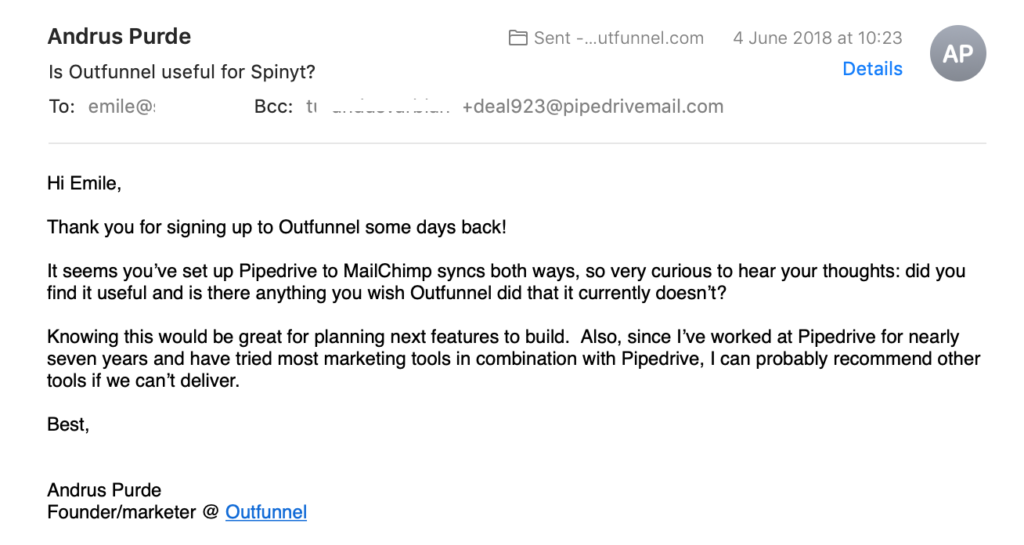
It was a somewhat tedious but illuminating period in building the company, and in defining our user onboarding process.
Epiphany: users tend to get stuck for similar reasons
First, it took a while to get anyone to respond.
Then, a picture started to emerge from replies, manually looking at user-profiles and their user journey, from onboarding calls made.
No matter which of the early onboarding pipeline stages people got stuck, they were stuck for similar reasons.
- No need. They had started the 14-day free trial on a whim, without a clear need or intent to buy. Nothing we could have said or done would have turned them into active users.
- No time. There was a need and our app looked promising, but there was no time to get things properly set up. Sending reminders during and after the trial got some of them back on track, and stating that this would take less than 15 mins was a nice extra incentive.
- No clarity. There was a need of some sort, but they couldn’t figure out how Outfunnel solved that need. Reiterating our core features, unique value proposition and better explanations got some of them to change their minds.
- Issues. No app is perfect, and this is especially true of our first version. The initial experience was far from ideal — there were bugs, infra hiccups, and UX dead ends, and unless we had completely messed up (which happened a couple of times), we could win some of those signups back.
If you look at these four reasons, you can address all of them by:
- reminding that you exist
- stating your value proposition and highlighting key customer benefit
- showing how setup takes 5-15 minutes, not hours and
- offering human contact i.e. scheduling a call.
So, we had to make addressing these reasons the goal of user onboarding.
Stage 2: Manual pipeline management, onboarding automated to people in the first three stages
And so we decided to stop looking at individual signups in the early stages of our onboarding pipeline and send all of them similar user onboarding emails, addressing the issues we had identified with the fixes we had seen to work.
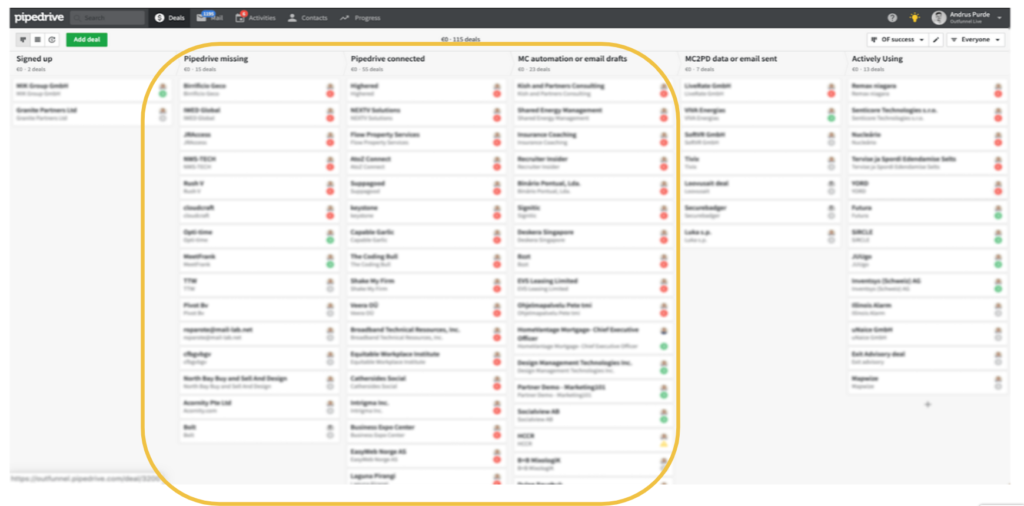
We still reviewed usage for each of the signups manually, but we stopped sending personalized emails to every single trial user manually.
Here’s an email that signups received the day after they had signed up:
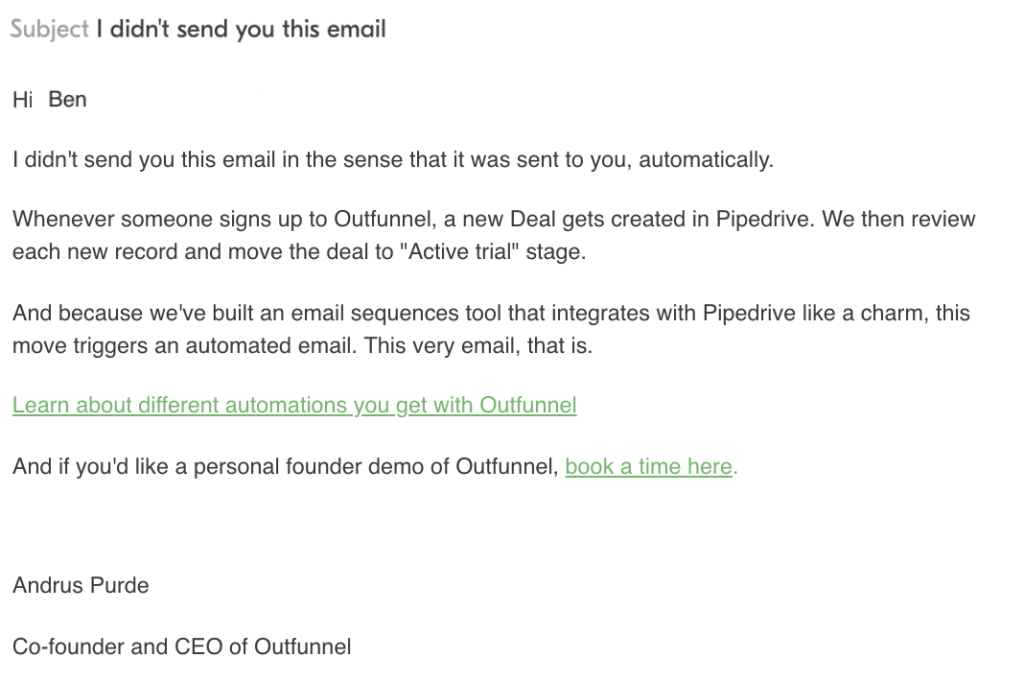
And here’s another one they received a day later:
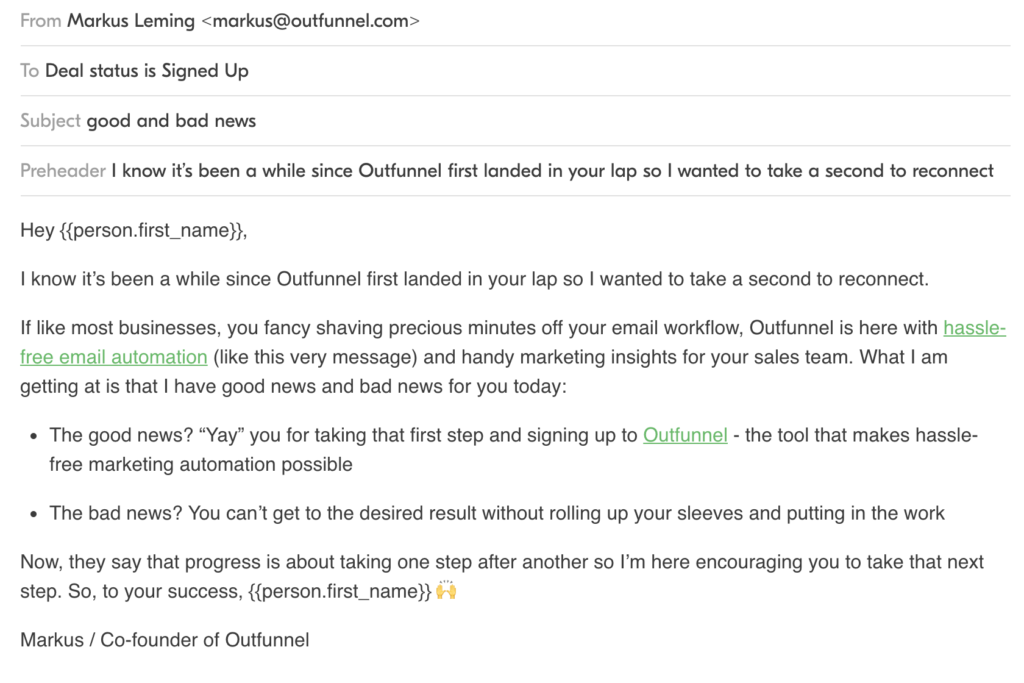
Our volume of signups had grown to 100-150 per month, so while it still took time to review usage stats for each a couple of times during the trial, we saved the time of sending “manual” emails to 65-75% of signups.
And this was a HUGE time win for us at the time.
Conversion to active trial users and trial-to-paid conversion remained the same, or even improved as we had more time to deal with active trial users.
Initially, we used the Mailchimp email platform to send these emails, but from June onwards we’ve been using Outfunnel’s own simple email campaigns tool to start the drip campaign and end it for those users that activate and start using their trial properly. More on our technical setup below.
Stage 3: Going full-automatic with user onboarding pipeline management, personal contact only where it made sense
Once this process had run smoothly for a couple of months, my colleague Markus wanted to take things further.
Pipedrive had released a workflow automation functionality which meant that it could auto-move deals in our onboarding pipeline based on any input. So our dev team built a basic API connection between our database and Pipedrive, sending usage data about events sent or synced to the CRM.
And we then set up a Pipedrive workflow automation to move each signup to the correct stage based on usage.
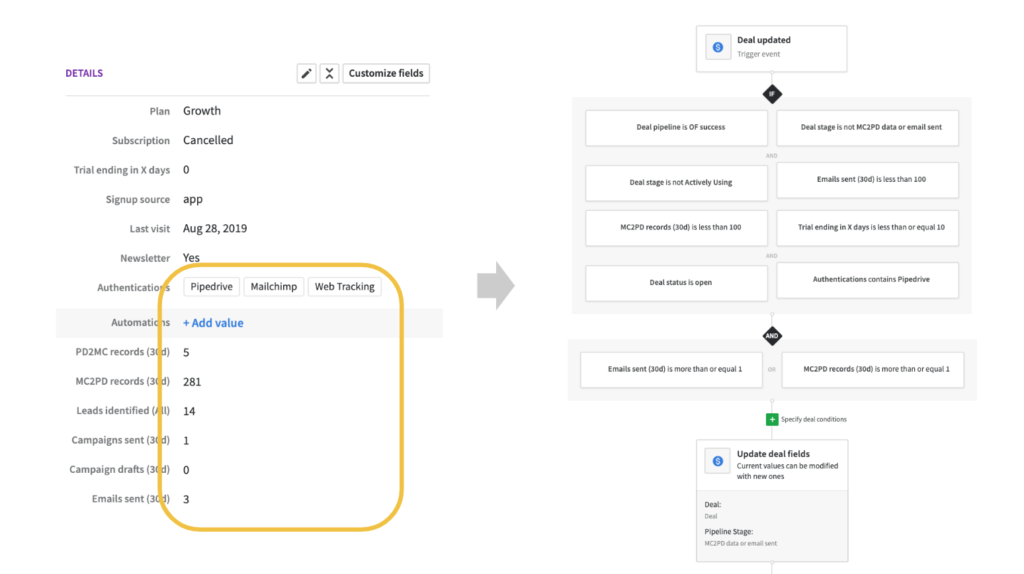
Our onboarding was now fully automated:
- Each signup sent to Pipedrive from Chargebee via Zapier
- App usage data sent from our database to Pipedrive via a custom solution, using Pipedrive API
- Each signup record moved to the correct stage automatically, using Pipedrive workflow automation
- Automated emails to people in the first 3 stages of the pipeline, using Outfunnel
All in all, this saved 80% if not 90% time spent on onboarding while maintaining or even increasing product engagement and conversion to paid because we had more time to spend with promising signups.
And please note that automating onboarding didn’t mean that we became inaccessible to new trial users. Quite the opposite. We knew human contact was important, and we actively encouraged responding to emails and/or scheduling a call via Calendly.
Here it’s worth noting that because Outfunnel has a tight integration with CRM’s data about email opens and clicks, and even website visits were synced back to the CRM.
So if a call was scheduled, you could just glance at someone’s profile in Pipedrive and immediately get a sense of what they had experienced and what messages had resonated with them.
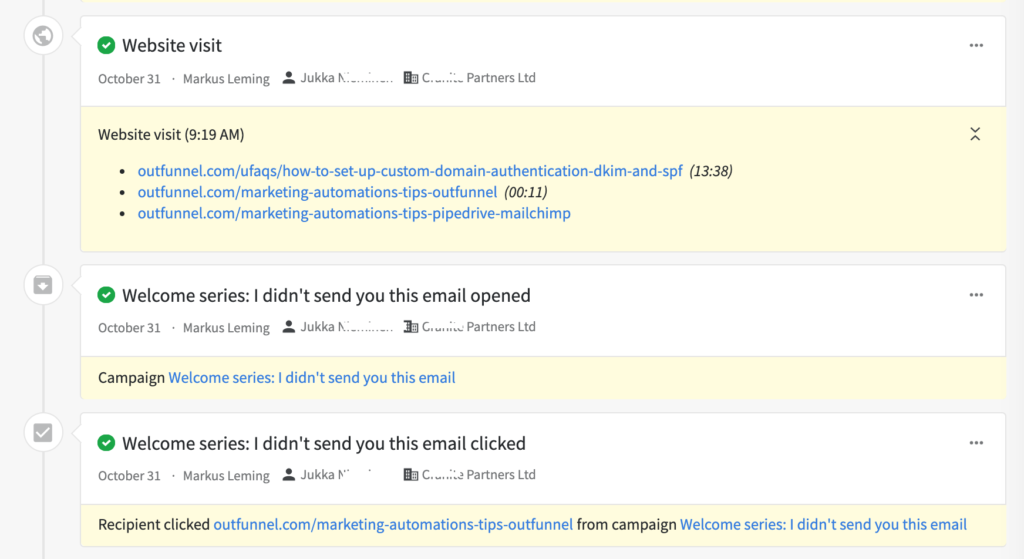
The technical bit: how we set up automated onboarding emails to people in the right pipeline stage(s)
At Outfunnel our raison d’etre is uniting sales and marketing, so sending emails to people in a specific pipeline stage (and stopping these emails once they’ve activated) was the easy bit.
Outfunnel works in a way where it’s easy to send targeted emails to any segment you’ve defined in your CRM. We were using Pipedrive, so below you’ll find information on our Pipedrive setup, but this would be equally simple with our Copper or Hubspot CRM integration.
Step 1. Define the group of people who should get automated emails in the CRM
We wanted emails to contacts in particular stages, so here’s the actual filter we had set up in Pipedrive:
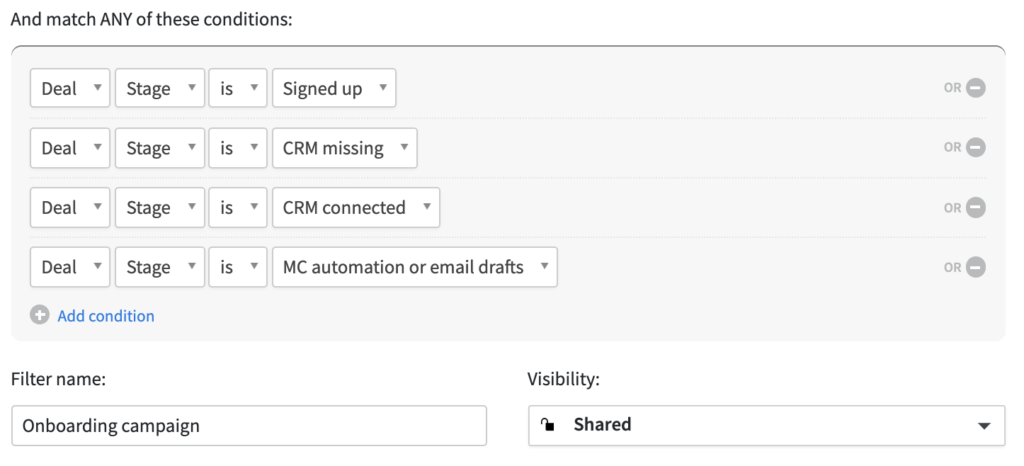
Step 2. Set up an email sequence in Outfunnel to send that segment
Because we already knew where people got stuck and what messages got then “unstuck” it was relatively easy to write the emails that went out. And, unsurprisingly, we used our own email tool for sending the campaign.
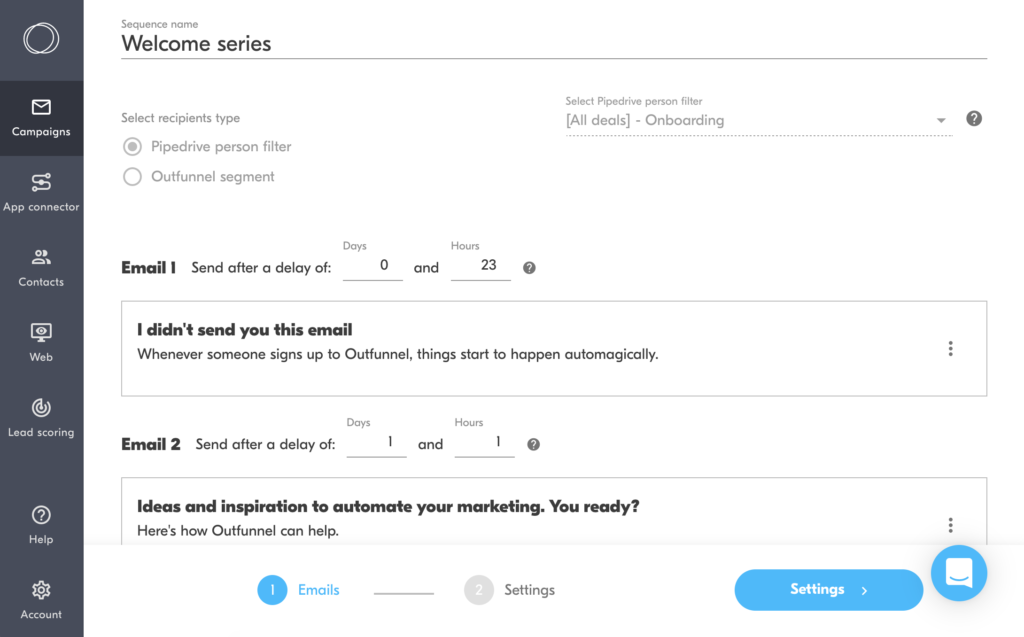
And that’s it. Setting up emails to go out automatically to a certain stage(s) of the pipeline was the least challenging bit in all of this.
Our user onboarding process automation results
These are our pipeline stats from the last 6 months:
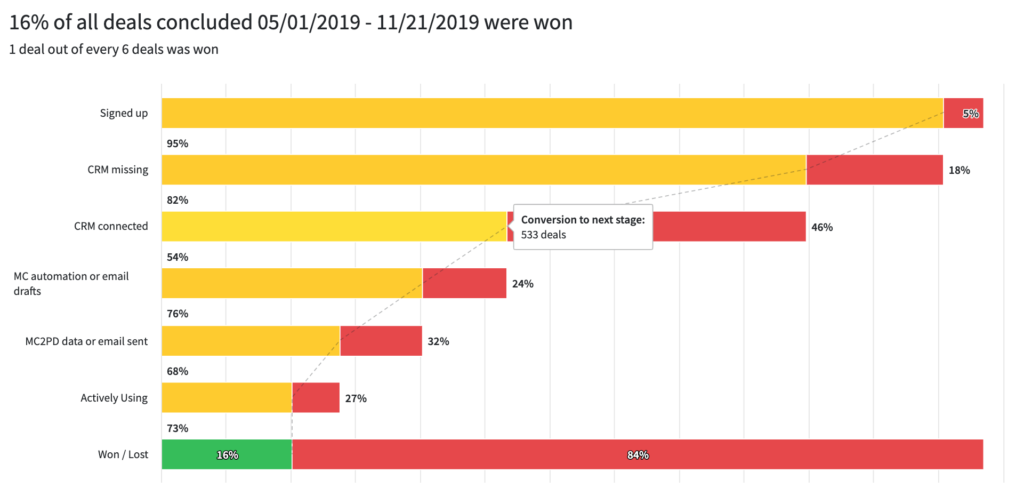
As you can see:
- 5% of signups are lost immediately because they are duplicates, spammy or otherwise completely unqualified.
- 78% of signups connect a CRM and so is technically capable of using the product. But only 42% of signups actually uses the product: sets up a campaign draft or configures automations.
- 31,7% actively engages with key features: sends out a campaign or syncs data through the system.
- 21% of signups became active tire-kickers with multiple campaigns sent and several features set up.
- And 73% of the last group, or 16% of all signups convert from the trial period to a paid subscription. And though our pipeline stages have been redefined a couple of times and we’ve saved A LOT of time with automation, we’ve kept this conversion rate.
So the first lesson is: you can save a lot of time with automation.
Other lessons learned about onboarding users
Speaking to customers is something we’ve done before we even started building the product, during various phases of building and onboarding.
This has taken a lot of time, but we literally would not have made it this far without it. It has helped us build a successful user onboarding experience, convert leads into active users, but also to prioritize roadmap, create great product experiences, tweak messaging and to get clarity around customer persona. Speaking to customers is super enlightening.
Last but not least, while you can get to an automated user onboarding process much faster than us, I wouldn’t completely skip any stages.
It’s a good idea to do something manually for long enough before you start automating.
In summary: it pays to automate your user onboarding funnel, but only AFTER you know the customer and where they get stuck. Addressing this is the one and only goal of onboarding.
P.S. Shout out to Markus who took over our onboarding flows at the end of 2018 and who has been the driving force behind our user onboarding automation efforts.
P.P.S. Looking for more inspiration? See some great onboarding email examples.
If you’re using Copper, Hubspot CRM or Pipedrive as your CRM, try out Outfunnel for connecting your sales and marketing data and ensure all customers a streamlined onboarding experience.

